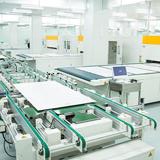

Silk screen processing technology is widely used in life, and the process seems simple to operate. However, there will always be a lot of problems in the actual operation process. So how does the screen printing factory solve the various problems that appear in the screen printing process, and how do these problems arise? In the process of silk screen printing, the corresponding solutions for different problems are listed below for your reference.
How does the silk screen factory solve various problems in the silk screen process
1. The printing ink layer has small bubbles
Reason analysis: the ink is too thick, there is air in the ink, the printing speed is too fast, the amount of ink is too much, the solvent volatilizes too fast
Solution: Add a slow-drying diluent to the ink. After the adjusted ink is placed for half an hour, wait for the air to be released and then screen-printed to reduce the printing speed and replace the squeegee with higher hardness.
2. Pinhole/trachoma
Reason analysis: the ink is too thin, small holes appear on the screen, the surface of the substrate is dusty, the squeegee pressure is too large, the screen distance is inappropriate, and the screen tension is too low.
Solution: add new ink, plug loopholes, clean the surface of the substrate, reduce the squeegee pressure, increase the screen distance, and check the screen tension.
3. Graphic defects after printing
Reason analysis: the screen is not clean, the surface of the substrate is not clean
Solution: Check the screen, clean the workplace and increase humidity, and clean the surface of the substrate.
4. The clarity of graphics and text after printing is not enough
Reason analysis: the ink is too thin, the pressure of the ink-returning knife is too large, the round scraper, the net distance is inappropriate, and the effect of static electricity.
Solution: Add new ink, reduce the pressure of the ink-returning knife, replace a suitable squeegee, increase the net distance, and add some methods of removing static electricity.
5. Uneven ink
Cause analysis: the surface of the substrate is defective, the ink is uneven, and the squeegee is chipped.
Solution: Improve the surface condition of the substrate or print a layer of transparent oil first; adjust the printing pressure balance of the equipment: achieve uniform ink return and uniform ink during printing, replace the screen printing squeegee.
Silk screen processing
6. Ink drying network and blocking network
Reason analysis: the ink is too thick, the ink particles are too thick, the room temperature is too high, the screen production is poor, the squeegee pressure is too large, the screen distance is large, and the squeegee hardness is not enough.
Solution: Clean the screen and dilute the ink, filter the ink, add a slow-drying solvent, adjust the exposure parameters and plate development, adjust the squeegee pressure, adjust the screen distance, and change the squeegee with higher hardness.
7. Inaccurate screen printing processing
Reason analysis: the screen image is deformed, the substrate is easy to shrink or expand, and the printing pressure of the screen printer is too high
Solution: Re-production of the screen and deformation of the substrate can maintain the constant temperature and humidity of the printing workshop and adjust the pressure of the screen printing machine to decrease.
Manual silk screen
8. Screen paste version
Reason analysis: the ink is too thin, the net spacing,
Solution: Adjust the ink thickness appropriately, and wipe the reverse side of the screen with the corresponding solvent.
Tel:15158365810
HTML:www.mysyqc.com
Add:No.185, bridge 3 road, xiaoqiaotou village, qiaotou town, cixi city